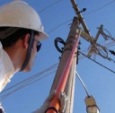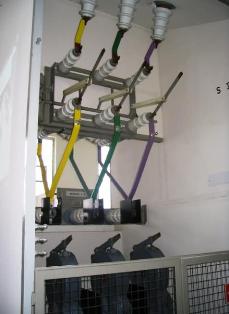Insulating rods
 Insulating rods by purpose are divided into operational and measuring.
Insulating rods by purpose are divided into operational and measuring.
Working insulating rods are intended for carrying out operations with single-pole disconnectors in closed switchgear with a voltage up to and including 35 kV, as well as for carrying out other operations, such as determining the location of bus vibrations, the hot spot of contacts or busbars, the presence of voltage (by spark or by means of a high voltage screw indicator), for operations with high voltage fuses or for cleaning the insulation of live equipment from dust.
Insulation measuring rods are designed to measure the potential distribution over a pendant string or over a column of pins, the resistance of contacts and connectors at operating current and temperature heating tires and live parts in the distribution system.
Insulating rod device
Each insulating rod consists of three main parts: a working part, an insulating part and a grip handle.
The working part of the insulating rod is either a metal tip having a shape depending on the purpose of the rod (operating rods) or a measuring head for various purposes (measuring rods). The working part is firmly attached to the insulator, which connects the working part to the grip handle.
The insulating part must be made of insulating material.
The handle for gripping the insulating rod is usually made of the same material as the insulating part and should be of such a length that a person can handle the rod without exerting more than 8 kg of force.
The individual detachable parts of the composite insulating rod are threaded to provide transition metal parts that are firmly attached to the insulating material.
When making the insulating part and the gripping handle both from one piece of material and from the component parts, an accent in the form of a ring with a diameter of 5-20 mm larger than the diameter of the gripping handle is made between the insulating part and the gripping handle . The stop limits the burn of the operator's hand so that they do not come close to the working part, thus reducing the length of the insulating part. Therefore, it is forbidden to mark the length of the insulating part of the rod with only a strip of paint.
The length of the insulating part of the rod is determined by the voltage of the electrical installation for which the insulating rod is intended.
The length of the measuring rods is determined by the distances at which the measurements are made. The measuring rods for voltages above 220 kV are made with the expectation that they will be operated by two people.
The size of the insulating part of the rod is determined, firstly, so that when touching live parts that are live, the leakage current does not exceed the permissible value and, secondly, so that the operator or his hands do not come within an unacceptably close distance to live parts during to avoid air trapping or thermal arc damage that may occur during operation.

Work universal tape SHOW-110
Work with insulating rods
When working with insulating rods, do not touch the insulating part with hands beyond the end stop. In order to increase the surface resistance and protect against moisture, the insulating part of the rods is covered with a layer of insulating varnish. Therefore, if the paint is damaged while working with the insulating rod, the work should be stopped and the rod should not be used , until the paint is restored and tested. This applies in particular to the measuring rods that measure the voltage distribution along the string from the support of the power line or from the structure of the switchgear, because when the rod is moved, it can be scratched on the metal structure.
Insulating rods intended for operation in closed switchgear should not be used in outdoor electrical installations during rain, fog, snowfall, rain.
When performing various operations with insulating rods, it is necessary to ensure that when approaching or touching the working part of the rod to live parts, its insulating part does not come close to the grounded parts or the live parts of other phases, as this reduces the insulation rod length.
The insulating bars are not grounded during operation.
In installations of 35 kV and above, in the absence of a voltage indicator, working rods are used to check the presence of voltage on live parts by means of a "spark".
When the end of the insulating rod comes close to live parts that are live, a capacitive charging current occurs — a spark jumps.
Insulating rods are also used to apply portable earthing so that personnel do not approach live parts that may be live due to the presence of residual charge, voltage induction from nearby parts that remain in service, or, finally , due to incomplete tripping of this section as a result of a fault, such as tripping of the voltage transformers on the low voltage side.
Insulating rods for applying portable grounding are made of any insulating material, including wood. The dimensions of their insulating part are the same as those of the working rods.
To connect the pulse line meter to the wire of the disconnected overhead line, a rod with a clamp on the end is also used, to which a flexible connecting wire is attached, and the other end is connected to the wiring from the pulse line meter.The insulating part of the rod is calculated for a voltage not less than the voltage of the given electrical installation. In practice, its length is determined by design considerations.
When testing electrical equipment with increased voltage, the charge remains energized after the voltage is removed. It is possible to start reconnecting the test leads supplying voltage to the equipment under test only after removing the charge by connecting the live parts of the equipment and the test lead to ground. For this purpose, a rod with a damping resistance and a ground wire connected to it is used. The length of the rod is not standardized, but for ease of use it should be at least 1 m. After touching the end of the rod to live parts and the test wire, the rod is suspended from the wire using a clamp or hook, while the end of operations to reconnect the test lead to another phase of the equipment. This measure is particularly important in DC cable testing where, due to the large capacitance of the cable, the charge is significant.
Insulating bars should only be handled from the ground or floor, without the use of ladders, etc., as it is possible for a person, having made any movement with the busbar, to lose his balance and fall on live parts or, in the most -good luck, on the floor...
If the voltage remains on the secondary winding of the transformer, for example from another transformer operating in parallel, then due to the phenomenon of reverse transformation, a high voltage will also remain on the terminals of the primary winding of the switched-off transformer.
When carrying the boom into the distributor, carry it horizontally by hand. Composite booms must be assembled directly at the boom job site.
Hollow insulating rods used to clean the insulation of closed distribution devices from dust without stress relief, before starting work and periodically during operation, must be cleaned of dust from the inside to prevent overlapping of the insulating part of the rod.
Operation of the dipstick from the switchgear structure or line support must be performed by two persons. One person must climb to the structure to the workplace and with the help of a rope raise the bar with the working part up, the other, standing on the ground, must guide the bar with the other end of the rope, not allowing it to hit the structure.
Long-length insulating rods for 500 kV electrical installations have an opening in the insulating part, for which, with the help of a nylon rope, the second worker maintains the rod in the desired position during the measurements. When working with a dipstick from a telescoping tower, the dipstick is fed from the ground to the fitter, which is located in the basket of the tower, assembled with the working part up. The tower is then raised to the desired height.
When operational insulating rods carry out operations with disconnectors, fuses, to check the presence of voltage, vibration of tires, when measuring the temperature of live parts under voltage, etc., it is necessary to use dielectric gloves for live electrical installations above 1000 V The same applies to insulating rods for applying portable earthing to live parts.
When working with measuring rods for measuring the voltage distribution on a string of insulators and when measuring the resistance of contacts and connectors, dielectric gloves cannot be used, since the work is carried out for a long time (several hours in a row) and the availability of gloves significantly complicates the work with the insulating rod.

